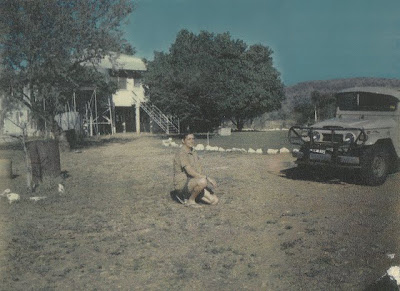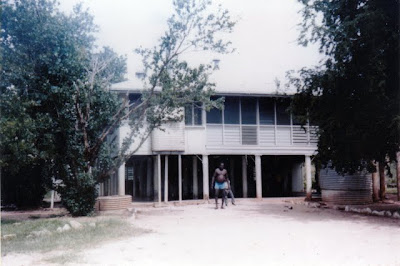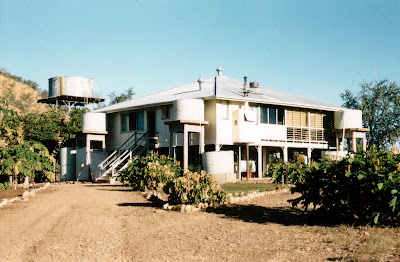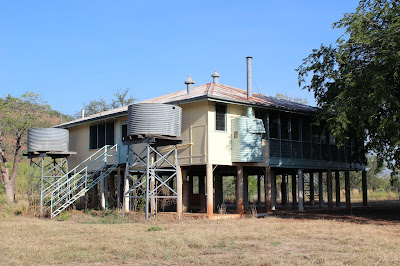Timber Creek is located on the Victoria Highway 280 KM West of Katherine and is 230 KM East of Kununurra in Western Australia.
The current patrol area is 86,000 square kilometres and includes over a dozen Aboriginal communites, numerous cattle stations, Gregory and Keep River National Parks and the Bradshaw Defence Training Ground.
A police station was first established in Timber Creek in 1898. Initially just a hut and a goat yard, the dwellings were upgraded to iron and steel in 1908, now the Timber Creek Police Station Museum. See right for links to the police stations at Timber Creek.

History of the Timber Creek Township: (from NTPFES station profile)
Timber Creek is the traditional land of the Ngaliwurra Aboriginal people, who provided early European settlers with valuable bush knowledge and acted as guides for police. Throughout the region Ngaringman is the main language except at Yarralin where it is Gurundji.
In 1855 the explorer Augustus Charles Gregory, financially backed by the Colonial Office, sailed from Moreton Bay, around the coast of Queensland and the Northern Territory and up the Victoria River. Gregory's boat was wrecked at the site of Timber Creek and it is claimed that Gregory named the site after cutting timber to repair his vessel. The site of Gregory's camp, known as Gregory's Tree Reserve, can be found to the west of the town. The boab tree with the date '2 July 1856' clearly carved in it can be accessed from a track which runs from a cairn on the Victoria Highway to the tree at the riverside. Over a period of eight months Gregory with various numbers of the expedition explored large areas of the Victoria River catchment and penetrated nearly 500 km south, along Sturt Creek, to the edge of the Great Sandy Desert.
Gregory was one of the many believers in an 'inland sea' within Australia’s centre. He explored the Elsey, Roper and McArthur Rivers, in 16 months travelling more than 8000 km. The subsequent settlement of the area resulted in Timber Creek becoming an important port for the surrounding cattle stations particularly Victoria River Downs Station which was then the largest pastoral enterprise in Australia. The river was used until the 1930s when road transport made it redundant.
From the Timber Creek Police Museum Records
“This is indeed a noble river!” Stokes wrote this is his diary on the 18th of October 1839. “….and worthy of being honoured with the name of her most gracious majesty the Queen.” (The Victoria River). Stokes was second-in-command under Captain Wickham of The Beagle. They had discovered the largest river in North Australia and proceeded to explored inland some 200 kilometres of the 640 kilometre river. The spot they reached on the 3rd of November 1839 became the Victoria River Depot. (This is about 5 kilometres from the current Police Station). The Victoria River, as wide as it is in parts, is difficult to navigate because of many sand and rock bars, and the swiftness of the tide adds significantly to problems. The Beagle’s difficulties resulted in the loss of two anchors. The next major expedition, led by Augustus Gregory in 1855, also had problems. The schooner, Tom Tough was grounded on a shoal, sustaining considerable damage. Good timber was required. Gregory’s journal on the 7th of November 1855 states. “The party which went up the river yesterday in search of timber for the repair of the vessel returned in the evening, having found some suitable melaleuca-trees on the bank of the creek below Steep Head”. The party was sent back to cut timber and Gregory visited their camp on the 14th of November. By the 24th of November he is referring to ‘Timber Creek”. Gregory went on to explore a large area of the Victoria River District and he reported very favourably on its pastoral potential. The success of Gregory’s expedition prompted much discussion in South Australia on settlement of this northern area. In December 1879 Charles Brown Fisher and J.Maurice Lyons applied for the first pastoral leases in the Victoria River District, by the end of 1882 there was over 100,000 square kilometres leased, the largest station being Victoria River Downs with an area of 41,155 square kilometres. In 1883 20,000 head of cattle arrived from Queensland to the area. The establishment of pastoral interest led inevitably to a clash of cultures, both as Aborigines and pastoralists did not recognise each other’s claim of tenure over the land. In this struggle, the pastoralists had an advantage of being able to enforce their claims through legislation of the day. This legislation entitled protection from people who killed cattle, and the need to establish a police station became apparent. The first station on the area was Gordon Creek Police Station, one officer, Mounted Constable Willshire and the equivalent of three of today’s ACPO’s Constables, Jim, Larry and George, left Palmerston (now Darwin) on the 1st of May 1894, enroute to establish the Gordon Creek Police Station. In January 1898 correspondence regarding the relocation of the station to Timber Creek was received and O’Keefe rode over on the 20th of April from Gordon Creek to select a site. Property was forwarded to Timber Creek for use at the new station. By Monday the 30th of May 1898, MC O’Keefe and trackers were the first police officers on duty at Timber Creek. Little is recorded of the first building erected in 1898 as the Timber Creek Police Station. It is described as a ‘bough hut’. There was also a shed for harness gear, goat yards and a large police paddock for the horses. These officers were houses in little more than tents, without their families by their sides. Ten years passed before the new station was built, it being completed on 10th of October 1908 (This building still stands today as the current Police Museum). Because of ongoing trouble with termites, it was decided to use a steel frame to erect the station. Materials were brought in by boat, along with a builder by the name of Charles Hansen. The trackers helped him, as did MC Dempsey and Holland. With the erection of the new building MC Dempsey lost no time in seeking permission to bring his wife and children to Timber Creek. Permission was refused on 4th November 1908. The building appears not to have been completed immediately, particularly the latticing on the veranda. In 1909 dry season, after having some difficulty in producing lime, the station men white-washed the building. The police made constant applications for a cell, complaining that it was most unsatisfactory to have prisoners chained to a tree, and most uncomfortable for them, particularly in the wet. However, a cell was not built until the second police station was erected in 1935. Many of the repairs and maintenance of the police premises had to be undertaken by the constables and their trackers and in localities like Timber Creek often took years for materials to arrive.
This booklet was produced in 1998 by Jane Munday and Kris Lee from the police media and Publications unit. You can view it as a presentation below. Note: to get full screen click 'Google Slides' on the bottom right of this window and then 'Present from the beginning' on the top right when the presentation opens.
Police stations
1898 Camp
1978 Station - current station
Timber Creek Police Museum O'Keefe Street, Timber Creek National Trust NT 16/11/1994 and 14/05/1991


Members Service Roll Members who served at Timber Creek Police Station Not every item in this list has been verified and has been drawn from a number of sources which do contain conflicts. If you can you add to or correct this list - contact the site email on the home or contact pages. Items in blue are from the honour role provided by the National Trust published in the History of Policing in Timber Creek at page 15. 1900's E O'Keefe - 11 Apr 1898 - 1905 G H Thompson - 31 Dec 1900 - 24 Sep 1901 E R Gordon - 22 Sep 1902 - 29 Mar 1904 J L Artaud - 24 Jul 1904 - 9 Jul 1908 F G Burt - 16 Jul 1905 - 27 Apr 1906 C A Dempsey - 9 Apr 1906 - June 1910 U W Holland - from 4 Jul 1908 A J A White - from Jul 1910 1920's 1930's W Langdon - 22 Se 1934 - 1935? G R Birt - 28 Jan 1935 D L Woodcock - 8 Jun 1935 - 1 Dec 1936 J Fitzgerald - 30 Nov 1936 - 23 Nov 1937 P Bruun - 20 Nov 1937 - 1938? V A B Riley - 3 Sep 1938 - 15 Nov 1940 Frank Deans - 10 Mar 1938 - 4 Sep 1938 1940's Gordon Stott - 9 Nov 1940 T C V Fitzer - 15 Nov 1940 - 15 June 1942# G Ryall - 31 July 1941 P Delderfield - 24 Apr 1946 - 1 Feb 1947 Bert Mettam - June or July 1949 - 1950 1950's Bob Savage - 1950 - 1951 B Parker - 20 Aug 1954 T C V Fitzer - Sept 1955 D G Conaghan - 11 Sep 1955 - 20 Sep 1957 Jim Conmee - 27 Aug 1956 - 29 Nov 1956 A J Gordon - 19 Sep 1957 - 3 Nov 1962 C E Tisdell - 26 Nov 1958 - 28 Feb 1959 1960's K J Pascoe - 20 Oct 1960 - 24 Jan 1961 K J Pascoe - 31 Oct 1962 - 27 May 1967 P R Hood - 12 Sep 1963 - 12 Dec 1964 J V Maley - 7 Jun 1965 - 5 Sep 1965 F E Saunders - 24 May 1967 - 22 Jun 1969 G F Hosking - 12 April 1968 - 24 Jul 1968 C E Taylor - 20 Jun 1969 - 28 Jun 1973 G F Hosking - 12 Nov 1969 - 12 Feb 1970 1970's A G Duncan - 27 Mar 1972 - 13 Apr 1972 V J Hoy - 9 Apr 1972 - 29 Jun 1972 Lynn Cox* - 27 Jun 1973 - 7 May 1974 R D Prosser - 8 Dec 1973 - 11 Feb 1974 John Gablesh - left 22 Dec 1974 after 10 months T J Milera - 12 Dec 1974 - 30 Oct 1975 J Scanlon - 30 Oct 1975 - 8 Mar 1976 T J Milera - 6 Mar 1976 - 3 Aug 1977 H W Simpson - 3 Sep 1977 - 18 May 1979 R H Kirby - 14 Jan 1979 - 20 Jan 1981 P M Jones - 23 Sep 1979 - 10 June 1981 1980's G T McPherson - 31 January 1981 - 27 February 1983 L R Waldron - 8 June 1981 - 8 October 1985 S D Young - 30 April 1983 - 6 August 1986 M J Plumb - 20 December 1985 - 6 July 1989 B J Thorp - 23 October 1986 - 19 October 1987 R V Mills - 12 December 1987 - 11 September 1990 C A Baird - 30 August 1989 - 21 January 1992
Trackers
Tracker George
'Bullita' Jack
Duncan McDonald - 1973 - 1983
Tracker Darby - 1950
Johnny Lingerimun (booklet p.6)
Kelly
Lightning
Chris Jones
Members details since 1990 not yet entered.
Refer NTPMHS database. *In a recent publication Harry Cox was incorrectly substituted for Lynn Cox in the associated pamphlet. This was incorrect as Harry Cox had not served at Timber Creek whereas Lynn Cox had. This was merely a transcription error and only mentioned here to avoid any confusion in the future.
#Tas Fitzer appears three times on the actual list with these two being close together. It is unsure if this is a second start date or the end date for the first tour.
'Tick' Kelly - 1909
J Kennett - 1920's
Lee - 4 September 1943 - no record of member by that name located
Reid - 1950's John Joseph 'Jack' Mahoney - 1950's
Sam Parsons - 1970's Roger Harvey - 1970's
The Capture of Humbert Tommy An excerpt from the Administrator Abbott of the Northern Territory Annual Report – Humbert Tommy , the aboriginal who speared Constable and Police Tracker George several months ago in the Victoria River Downs country, has now realised that his Nemesis, in the form of Constable Fitzer, of the Northern Territory Police Force, was at his heels ever since he fled into the fastnesses of the rugged country around the Victoria River. Fitzer regarded the spearing of his best tracker as almost a matter of personal honour; and, although he was due for over nine months leave in which he intended to spend abroad, asked that his leave might be deferred until he had arrested Humbert Tommy. This was granted by Superintendent Stretton, and Fitzer set out once more for the country he knows so well. The Constable, with a tracker named Jaberoo, and an aboriginal borrowed from a nearby station, reached Victoria River Downs country on 10th October, and camped in the bush, combing both banks of the river for tracks and camps. He missed Humbert Tommy by two days at one camp. A few days later, Fitzer found that Tommy had fled into the rough country around Mount Sanford. Here the Constable had to wait for five days, until his police plant of horses caught him up. When this came, he set out through the bush and hills to Mount Sanford, travelling at night and keeping away from any roads or tracks. He reached his destination in four days and surprised a camp, but Tommy again fled. Fitzer then patrolled all the outlying waters, covering a radius of 120 miles, but only found old tracks. A day or so later, the Constable detected fresh tracks near the old Gordon Downs Stockyards and sent his three trackers, Jaberoo, Sandy and Frank, to reconnoitre along the crests of the hills, and one returned to say that they had located a big camp of blacks, who had just killed a branded cow and they were feasting. The other native trackers stayed watching the camp, and remained unseen themselves. Fitzer was then able to question four Aboriginals, who admitted that they had been running with Humbert Tommy for some time; and admitted that Tommy had left them only the day before and had made for his own country, the Humbert River, where he was hiding in the hills. Fitzer picked up Tommy’s fresh tracks, and followed them all that day and into the night, when he was very close to the Humbert River. All that night the Constable and his trackers searched, and in the morning they found that a few hours previously Tommy had swum along the river to baffle his pursuers. The circle of police and trackers closed in on the fleeing black, and early the next morning Tracker Frank came across Tommy, who had given up his flight as hopeless, and was waiting to be arrested. He was brought to Darwin, where he will be tried for attempted murder. The Administrator said he had released the story of the arrest as it was such a good example of determination and skill, with splendid assistance by natives, who realised that Humbert Tommy was a fugitive from justice. It also showed, added Mr Abbott that the Northern Territory Police Force was as efficient and skilful in bushcraft as ever; and in Constable Fitzer’s case, all personal desires had been set aside in order to carry out his duty. This story was given to the NTPMHS by Tasman Fitzer’s niece Pam Rixon.
In the late 1920’s police added to their ever increasing role, now also being the local post office. Officers of this day conducted general policing and were also the local medic’s, often stitching people up and distributing what limited medicines were available at the time. In 1935 a decision was made to place two married officers in Timber Creek, building a station similar to those at Daly River and Roper River. At the same time 300 pounds was spent on repairs to the old station. See documents for Gordon Creek members etc. William Willshire - Gordon Creek Nicholas Waters - possibly Gordon Creek
1935 Station - Timber Creek





















Comments